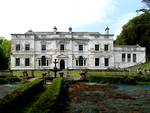Greenway Halt railway station (Devon)
Heritage railway stations in DevonPages with no open date in Infobox stationRailway request stops in Great BritainRailway stations built for UK heritage railwaysRailway stations in Great Britain opened in 2012 ... and 1 more
Use British English from May 2017

Greenway Halt railway station is a small railway station on the Dartmouth Steam Railway, a heritage railway in Devon, England. It is situated near the northern end of the 495-yard (1,485-foot; 453-metre) long Greenway Tunnel and convenient for visitors to the Greenway Estate, the historic home of Agatha Christie.
Excerpt from the Wikipedia article Greenway Halt railway station (Devon) (License: CC BY-SA 3.0, Authors, Images).Greenway Halt railway station (Devon)
Greenway Road, South Hams Kingswear
Geographical coordinates (GPS) Address Website External links Nearby Places Show on map
Geographical coordinates (GPS)
| Latitude | Longitude |
|---|---|
| N 50.3863 ° | E -3.5732 ° |
Address
Greenway Halt
Greenway Road
TQ5 0ES South Hams, Kingswear
England, United Kingdom
Open on Google Maps









